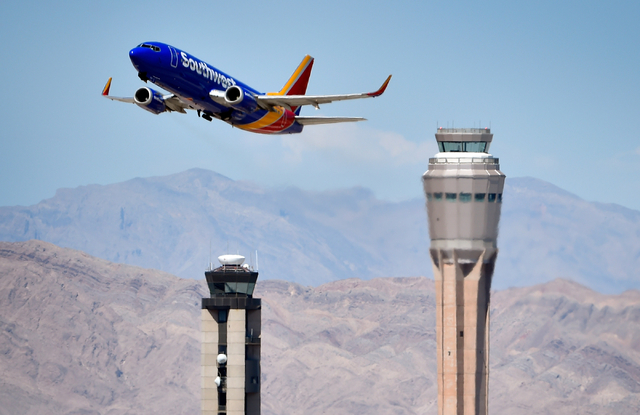Aviation industry leaders are looking anxiously but optimistically at lawmakers successfully meeting a Sept. 30 deadline for legislation for reauthorising the Federal Aviation Administration.
Rep. Dina Titus, D-Nev., expects to be one of the key figures in the effort to win congressional approval.
Titus gathered experts to address aviation issues critical to Southern Nevada in the first Titus Aviation Symposium on Monday at the National Atomic Testing Museum.
The FAA, which oversees the safety of American airspace with policy and regulations for airlines, airports and the nation’s air traffic control system, has plenty on its plate developing a next-generation air traffic control system, drafting regulations for unmanned aerial vehicles and weighing in on matters that ultimately affect Southern Nevada’s ability to transport visitors to the city.
Titus considered the event a success.
“This is definitely something we plan to continue in the years ahead,” said Titus, who also delivered FAA administrator Michael Huerta as keynote speaker for the event that drew about 200 people.
Huerta also used the symposium setting to announce that Las Vegas would be the location of a public hearing later this year to discuss issues surrounding unmanned aerial vehicle policy.
While Nevada is fast becoming one of the nation’s hotbeds for testing unmanned aerial systems, it’s also home to a philosophical mindset concerned with what an increase of drones could mean to the right to privacy.
In addition to announcing the upcoming hearing, Huerta also gave a brief update on the new 352-foot FAA tower at McCarran. He said the FAA would take possession of the tower from the contractor this summer and would begin moving equipment inside so that it would become operational in 2016.
Local aviation leaders from business and government introduced panel discussions on the importance of aviation to Southern Nevada’s tourism economy, the coming integration of unmanned aerial vehicles — commonly called drones — into the nation’s airspace and the role of Nevada’s aviation equipment manufacturers in the process.
The reauthorization of the FAA was the hottest topic of the early panel sessions.
Virtually every aspect of aircraft operations is tied to the reauthorization of the FAA. In 2012, the last time Congress reauthorized funding for the agency that oversees the safety of the nation’s airspace, short-term funding extensions were added 23 times, leaving manufacturers, airlines and industry policymakers uncertain about how to pursue long-term big-ticket goals, including the establishment of a satellite-based next-generation air traffic control system.
A next-generation system would enable air-traffic controllers to manage airspace more efficiently, adding capacity to the airspace — an important attribute for a destination like Las Vegas that depends on flights to grow its economy.
The industry has the added burden of dealing with drones, which will have a variety of uses that will increase efficiencies for a number of enterprises.
In the closing panel, representatives of the drone industry discussed the importance of expanding the aviation safety culture into the unmanned realm, but that’s growing more difficult as they become easier to acquire by hobbyists or casual fliers who disregard safety issues.
As a result, regulators have been reviewing regulations at a much slower pace, making sure they cover all bases when considering unmanned systems, regardless of their size.
The FAA has modified its regulatory course, opting to approve more regulatory exemptions to trusted drone fliers than focusing on establishing rules that vary depending on the size of the vehicle. The agency also is stepping up education, addressing students about safety protocols at a young age.
On the technology side, industry experts are working harder to develop collision-avoidance and sense-and-avoid systems to reduce the chances of midair collisions between aircraft and drones flown unsafely by amateur fliers or pilots ignoring FAA drone flight rules.
Photo: David Becker/Las Vegas Review-Journal
Source: Las Vegas Review

